Horus
Horus or Her, Heru, Hor, Har in Ancient Egyptian, is one of the most significant ancient Egyptian deities who served many functions, most notably god of kingship and the sky. He was worshipped from at least the late prehistoric Egypt until the Ptolemaic Kingdom and Roman Egypt. Different forms of Horus are recorded in history and these are treated as distinct gods by Egyptologists.[2] These various forms may possibly be different manifestations of the same multi-layered deity in which certain attributes or syncretic relationships are emphasized, not necessarily in opposition but complementary to one another, consistent with how the Ancient Egyptians viewed the multiple facets of reality.[3] He was most often depicted as a falcon, most likely a lanner falcon or peregrine falcon, or as a man with a falcon head.[4]
| Horus | |||
|---|---|---|---|
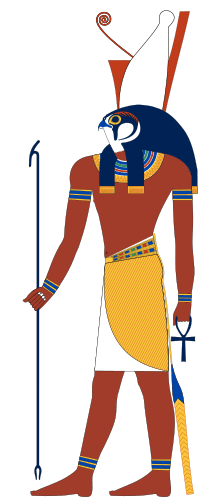 Horus was often the ancient Egyptians' national tutelary deity. He was usually depicted as a falcon-headed man wearing the pschent, or a red and white crown, as a symbol of kingship over the entire kingdom of Egypt. | |||
| Name in hieroglyphs | |||
| Major cult center | Nekhen, Edfu[1] | ||
| Symbol | Eye of Horus | ||
| Personal information | |||
| Parents | Osiris and Isis | ||
| Siblings | Anubis,[lower-alpha 1] Bastet | ||
| Consort | Hathor | ||
| Offspring | Ihy | ||
The earliest recorded form of Horus is the tutelary deity of Nekhen in Upper Egypt, who is the first known national god, specifically related to the ruling pharaoh who in time came to be regarded as a manifestation of Horus in life and Osiris in death.[2] The most commonly encountered family relationship describes Horus as the son of Isis and Osiris, and he plays a key role in the Osiris myth as Osiris's heir and the rival to Set, the murderer and brother of Osiris. In another tradition Hathor is regarded as his mother and sometimes as his wife.[2]
Claudius Aelianus wrote that Egyptians called the god Apollo, 'Horus' in their own language .[5]
Etymology
| ḥr "Horus" in hieroglyphs |
|---|
Horus is recorded in Egyptian hieroglyphs as ḥr.w "Falcon"; the pronunciation has been reconstructed as /ˈħaːruw/. Additional meanings are thought to have been "the distant one" or "one who is above, over".[6] As the language changed over time, it appeared in Coptic varieties variously as /hoːɾ/ or /ħoːɾ/ and was adopted into ancient Greek as Ὧρος Hōros (pronounced at the time as /hɔ̂ːros/). It also survives in Late Egyptian and Coptic theophoric name forms such as Siese "son of Isis" and Harsiese "Horus, Son of Isis".
Nekheny may have been another falcon god worshipped at Nekhen, city of the falcon, with whom Horus was identified from early on.
Horus may be shown as a falcon on the Narmer Palette, dating from about the 31st century BC.
Horus and the pharaoh
The Pyramid Texts (c. 2400–2300 BC) describe the nature of the pharaoh in different characters as both Horus and Osiris. The pharaoh as Horus in life became the pharaoh as Osiris in death, where he was united with the other gods. New incarnations of Horus succeeded the deceased pharaoh on earth in the form of new pharaohs.[7]
The lineage of Horus, the eventual product of unions between the children of Atum, may have been a means to explain and justify pharaonic power. The gods produced by Atum were all representative of cosmic and terrestrial forces in Egyptian life. By identifying Horus as the offspring of these forces, then identifying him with Atum himself, and finally identifying the Pharaoh with Horus, the Pharaoh theologically had dominion over all the world.
Origin mythology
| Part of a series on |
| Ancient Egyptian religion |
|---|
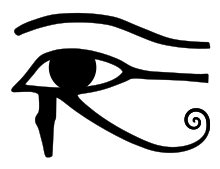 |
|
Beliefs |
|
Practices
|
|
Deities (list) |
|
Locations |
|
Symbols and objects
|
|
Related religions
|
|
|
Horus was born to the goddess Isis after she retrieved all the dismembered body parts of her murdered husband Osiris, except his penis, which was thrown into the Nile and eaten by a catfish,[8][9] or sometimes depicted as instead by a crab, and according to Plutarch's account used her magic powers to resurrect Osiris and fashion a phallus[10] to conceive her son (older Egyptian accounts have the penis of Osiris surviving).
After becoming pregnant with Horus, Isis fled to the Nile Delta marshlands to hide from her brother Set, who jealously killed Osiris and who she knew would want to kill their son.[11] There Isis bore a divine son, Horus.
Mythological roles
| rˁ-ḥr-3ḫty "Ra-Horakhty" in hieroglyphs |
|---|
Sky god
Since Horus was said to be the sky, he was considered to also contain the Sun and Moon.[12] It became said that the Sun was his right eye and the Moon his left, and that they traversed the sky when he, a falcon, flew across it. Later, the reason that the Moon was not as bright as the Sun was explained by a tale, known as The Contendings of Horus and Seth. In this tale, it was said that Set, the patron of Upper Egypt, and Horus, the patron of Lower Egypt, had battled for Egypt brutally, with neither side victorious, until eventually, the gods sided with Horus.
As Horus was the ultimate victor he became known as ḥr.w wr "Horus the Great", but more usually translated "Horus the Elder". In the struggle, Set had lost a testicle, and Horus' eye was gouged out.
Horus was occasionally shown in art as a naked boy with a finger in his mouth sitting on a lotus with his mother. In the form of a youth, Horus was referred to as nfr ḥr.w "Good Horus", transliterated Neferhor, Nephoros or Nopheros (reconstructed as naːfiru ħaːruw).
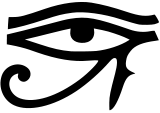
The Eye of Horus is an ancient Egyptian symbol of protection and royal power from deities, in this case from Horus or Ra. The symbol is seen on images of Horus' mother, Isis, and on other deities associated with her. In the Egyptian language, the word for this symbol was "wedjat" (wɟt).[13][14] It was the eye of one of the earliest of Egyptian deities, Wadjet, who later became associated with Bastet, Mut, and Hathor as well. Wadjet was a solar deity and this symbol began as her all-seeing eye. In early artwork, Hathor is also depicted with this eye.[15] Funerary amulets were often made in the shape of the Eye of Horus. The Wedjat or Eye of Horus is "the central element" of seven "gold, faience, carnelian and lapis lazuli" bracelets found on the mummy of Shoshenq II.[16] The Wedjat "was intended to protect the king [here] in the afterlife"[16] and to ward off evil. Egyptian and Near Eastern sailors would frequently paint the symbol on the bow of their vessel to ensure safe sea travel.[17]
Conflict between Horus and Set
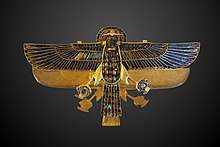
Horus was told by his mother, Isis, to protect the people of Egypt from Set, the god of the desert, who had killed Horus' father, Osiris.[18][19] Horus had many battles with Set, not only to avenge his father, but to choose the rightful ruler of Egypt. In these battles, Horus came to be associated with Lower Egypt, and became its patron.
According to The Contendings of Horus and Seth, Set is depicted as trying to prove his dominance by seducing Horus and then having sexual intercourse with him. However, Horus places his hand between his thighs and catches Set's semen, then subsequently throws it in the river so that he may not be said to have been inseminated by Set. Horus (or Isis herself in some versions) then deliberately spreads his own semen on some lettuce, which was Set's favorite food. After Set had eaten the lettuce, they went to the gods to try to settle the argument over the rule of Egypt. The gods first listened to Set's claim of dominance over Horus, and call his semen forth, but it answered from the river, invalidating his claim. Then, the gods listened to Horus' claim of having dominated Set, and call his semen forth, and it answered from inside Set.[20][21]

However, Set still refused to relent, and the other gods were getting tired from over eighty years of fighting and challenges. Horus and Set challenged each other to a boat race, where they each raced in a boat made of stone. Horus and Set agreed, and the race started. But Horus had an edge: his boat was made of wood painted to resemble stone, rather than true stone. Set's boat, being made of heavy stone, sank, but Horus' did not. Horus then won the race, and Set stepped down and officially gave Horus the throne of Egypt.[23] After the New Kingdom, Set was still considered lord of the desert and its oases.[24]
In many versions of the story, Horus and Set divide the realm between them. This division can be equated with any of several fundamental dualities that the Egyptians saw in their world. Horus may receive the fertile lands around the Nile, the core of Egyptian civilization, in which case Set takes the barren desert or the foreign lands that are associated with it; Horus may rule the earth while Set dwells in the sky; and each god may take one of the two traditional halves of the country, Upper and Lower Egypt, in which case either god may be connected with either region. Yet in the Memphite Theology, Geb, as judge, first apportions the realm between the claimants and then reverses himself, awarding sole control to Horus. In this peaceable union, Horus and Set are reconciled, and the dualities that they represent have been resolved into a united whole. Through this resolution, order is restored after the tumultuous conflict.[25]
Egyptologists have often tried to connect the conflict between the two gods with political events early in Egypt's history or prehistory. The cases in which the combatants divide the kingdom, and the frequent association of the paired Horus and Set with the union of Upper and Lower Egypt, suggest that the two deities represent some kind of division within the country. Egyptian tradition and archaeological evidence indicate that Egypt was united at the beginning of its history when an Upper Egyptian kingdom, in the south, conquered Lower Egypt in the north. The Upper Egyptian rulers called themselves "followers of Horus", and Horus became the tutelary deity of the unified nation and its kings. Yet Horus and Set cannot be easily equated with the two halves of the country. Both deities had several cult centers in each region, and Horus is often associated with Lower Egypt and Set with Upper Egypt. Other events may have also affected the myth. Before even Upper Egypt had a single ruler, two of its major cities were Nekhen, in the far south, and Nagada, many miles to the north. The rulers of Nekhen, where Horus was the patron deity, are generally believed to have unified Upper Egypt, including Nagada, under their sway. Set was associated with Nagada, so it is possible that the divine conflict dimly reflects an enmity between the cities in the distant past. Much later, at the end of the Second Dynasty (c. 2890–2686 BCE), Pharaoh Seth-Peribsen used the Set animal to writing his serekh name in place of the falcon hieroglyph representing Horus. His successor Khasekhemwy used both Horus and Set in the writing of his serekh. This evidence has prompted conjecture that the Second Dynasty saw a clash between the followers of the Horus king and the worshippers of Set led by Seth-Peribsen. Khasekhemwy's use of the two animal symbols would then represent the reconciliation of the two factions, as does the resolution of the myth.[26]
Heru-pa-khered (Horus the Younger)
Horus the Younger, Harpocrates to the Ptolemaic Greeks, is represented in the form of a youth wearing a lock of hair (a sign of youth) on the right of his head while sucking his finger. In addition, he usually wears the united crowns of Egypt, the crown of Upper Egypt and the crown of Lower Egypt. He is a form of the rising sun, representing its earliest light.
Golden Horus Osiris
Horus gradually took on the nature as both the son of Osiris and Osiris himself. He was referred to as Golden Horus Osiris.[27][28][29][30][31] In the temple of Denderah he is given the full royal titulary of both that of Horus and Osiris. He was sometimes believed to be both the father of himself as well as his own son, and some later accounts have Osiris being brought back to life by Isis.[32]
Her-ur
| Heru-ur | |
|---|---|
God of Nekhen, Egypt, and the pharaohs | |
Wall relief of Her-ur at the temple of Edfu, Egypt | |
| Major cult center | Heliopolis, Gizah |
| Symbol | hieracosphinx, hawk, lion, winged sun disk |
| Personal information | |
| Parents | Geb and Nut |
| Siblings | Osiris, Isis, Set, and Nephthys |
| Consort | Serqet, Hathor |
| Offspring | Imset, Hapi, Duamutef, Qebehsenuef |
Heru-ur, also known as Horus the Elder or Har wer, was a form of Horus, where he was the son of Geb and Nut. He was one of the oldest gods of ancient Egypt. He became the patron of Nekhen (Hierakonpolis) and the first national god ("God of the Kingdom") and was depicted as a hieracosphinx, a creature with a lion's body and a hawk's head and wings. Later, he also became the patron of the pharaohs, and was called the son of truth[33] – signifying his role as an important upholder of Maat. His right eye was the Sun and the left one was the Moon. Her-ur was sometimes depicted fully as a hawk, he was sometimes given the title Kemwer, meaning "(the) great black (one)".
The Greek form of Her-ur is Haroeris or Harmakhis. Other variants include Hor Merti 'Horus of the two eyes' and Horkhenti Irti.[34]
It was believed that he was the inspiration for the Sphinx of Gizah, constructed under the order of Khafre, whose head it depicts.
Celebrations of Horus
Macrobius' Chronicon noted the annual ancient Egyptian celebration of Horus, specifying the time as the winter solstice. An analysis of the works of Epiphanius of Salamis noted the Egyptian winter solstice celebration of Horus in Panarion.[35]
In popular culture
Influences on Christianity
William R. Cooper's 1877 book and Acharya S's self-published 2008 book have suggested that there are many similarities between the story of Horus and the much posterior story of Jesus.[36][37] However, this has been refuted by both Christian and non-Christian scholars.[38][39][40][41]
Gallery
 God Horus as a falcon wearing the Double Crown of Egypt. 27th dynasty. State Museum of Egyptian Art, Munich
God Horus as a falcon wearing the Double Crown of Egypt. 27th dynasty. State Museum of Egyptian Art, Munich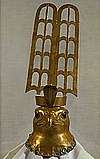 Horus, patron deity of Hierakonpolis (near Edfu), the predynastic capital of Upper Egypt. Its head was executed by means of beating the gold then connecting it with the copper body. A uraeus is fixed to the diadem which supports two tall openwork feathers. The eyes are inlaid with obsidian. Sixth Dynasty.
Horus, patron deity of Hierakonpolis (near Edfu), the predynastic capital of Upper Egypt. Its head was executed by means of beating the gold then connecting it with the copper body. A uraeus is fixed to the diadem which supports two tall openwork feathers. The eyes are inlaid with obsidian. Sixth Dynasty.- Horus represented in relief with Wadjet and wearing the double crown. Mortuary Temple of Hatshepsut
 Horus relief in the Temple of Edfu
Horus relief in the Temple of Edfu Statue of Horus from the reign of Amenhotep II (Eighteenth Dynasty, ca. 1400 BCE) in the Musée royal de Mariemont, Belgium
Statue of Horus from the reign of Amenhotep II (Eighteenth Dynasty, ca. 1400 BCE) in the Musée royal de Mariemont, Belgium.jpg)
See also
Notes
- (in some accounts)
References
- Sims, Lesley (2000). "Gods & goddesses". A Visitor's Guide to Ancient Egypt. Saffron Hill, London: Usborne Publishing. p. 29. ISBN 0-7460-30673.
- "The Oxford Guide: Essential Guide to Egyptian Mythology", Edited by Donald B. Redford, Horus: by Edmund S. Meltzer, pp. 164–168, Berkley, 2003, ISBN 0-425-19096-X
- "The Oxford Guide: Essential Guide to Egyptian Mythology", Edited by Donald B. Redford, p106 & p165, Berkley, 2003, ISBN 0-425-19096-X
- Wilkinson, Richard H. (2003). The Complete Gods and Goddesses of Ancient Egypt. Thames & Hudson. p. 202.
- Aelian, Characteristics of Animals, 10.14
- Meltzer, Edmund S. (2002). Horus. In D. B. Redford (Ed.), The ancient gods speak: A guide to Egyptian religion (pp. 164). New York: Oxford University Press, USA.
- Allen, James P. (2005). The Ancient Egyptian Pyramid Texts. Society of Biblical Literature. ISBN 978-1-58983-182-7.CS1 maint: ref=harv (link)
- New York Folklore Society (1973). "New York folklore quarterly". 29. Cornell University Press. p. 294.
- Ian Shaw (2003). The Oxford History of Ancient Egypt. Oxford University Press. ISBN 978-0-19-815034-3.
- Piotr O. Scholz (2001). Eunuchs and castrati: a cultural history. Markus Wiener Publishers. p. 32. ISBN 978-1-55876-201-5.
- Roy G. Willis (1993). World Mythology. Macmillan. p. 43. ISBN 978-0-8050-2701-3.
- "Horus". Ancient History Encyclopedia. Retrieved 2019-02-22.
- Pommerening, Tanja, Die altägyptischen Hohlmaße (Studien zur Altägyptischen Kultur, Beiheft 10), Hamburg, Helmut Buske Verlag, 2005
- M. Stokstad, "Art History"
- "Lady of the West". hethert.org. Archived from the original on 27 January 2010. Retrieved 18 January 2015.
- Silverman, David P. (1997). "Egyptian Art". Ancient Egypt. Duncan Baird Publishers. p. 228.
- Charles Freeman, The Legacy of Ancient Egypt, Facts on File, Inc. 1997. p. 91
- "The Goddesses and Gods of Ancient Egypt". Archived from the original on 4 June 2010.
- "Ancient Egypt: the Mythology – Horus". egyptianmyths.net.
- Scott David Foutz. "Theology WebSite: Etext Index: Egyptian Myth: The 80 Years of Contention Between Horus and Seth". theologywebsite.com. Retrieved 18 January 2015.
- Fleming, Fergus, and Alan Lothian. The Way to Eternity: Egyptian Myth. Duncan Baird Publishers, 1997. pp. 80–81
- "Figure of a Horus Falcon". The Walters Art Museum.
- Mythology, published by DBP, Chapter: Egypt's divine kingship
- te Velde, Herman (1967). Seth, God of Confusion: A Study of His Role in Egyptian Mythology and Religion. Probleme der Ägyptologie 6. Translated by van Baaren-Pape, G. E. (2nd ed.). Leiden: E. J. Brill. ISBN 978-90-04-05402-8.CS1 maint: ref=harv (link)
- te Velde 1967, pp. 59–63.
- Meltzer in Redford, pp. 165–166
- Yoyotte, Jean, Une notice biographique du roi Osiris, BIFAO 77 (1977), p.145
- Hymn to Osiris Un-Nefer, Translated by E.A.Wallis Budge
- Budge, E.A. Wallis ; 1901, Egyptian Magic, Kegan, Paul, Trench and Trübner & Co., London
- "The Abydos Triad, Osiris, Isis and Horus, and Seth". www.reshafim.org.il.
- Roxburgh, Kevin. "Horus - Egyptian God Horus - Egyptian Mythology - Horus - Eye of Horus". www.egyptiangods.co.uk.
- E.A. Wallis Budge, Osiris and the Egyptian resurrection, Volume 2 (London: P. L. Warner; New York: G. P. Putnam's Sons, 1911), 31.
- Wilson, Erasmus (January 1, 1877). Cleopatra's needle: With brief notes on Egypt and Egyptian obelisks. London: Brain & Company. p. 208. Retrieved 6 December 2014.
- Patricia Turner, Charles Russell Coulter, Dictionary of ancient deities, 2001.
- "MACROBIUS, Saturnalia – Loeb Classical Library". Loeb Classical Library.
- Murdock, D. M.; S, Acharya (December 2008). Christ in Egypt: The Horus-Jesus Connection. Stellar House Publishing. ISBN 978-0-9799631-1-7.
- Cooper, William Ricketts (1877). The Horus Myth in Its Relation to Christianity. Hardwicke & Bogue. p. 3.
jesus horus.
- Ehrman, Bart D. (2012). Did Jesus Exist?: The Historical Argument for Jesus of Nazareth. HarperOne. ISBN 978-0062206442.
- C Henderson, S Hayes, Debunking the Horus-Jesus Connection, 2015, Minneapolis: Fortress Press, 1996
- Houdmann, S. Michael, Questions about Jesus Christ, WestBow Press, 2013
- Klar, Sonnen, Seeking Hard Evidence for the Similarity of the Horus and Jesus Myths, Richard Dawkins Foundation
External links
| Wikimedia Commons has media related to Horus. |